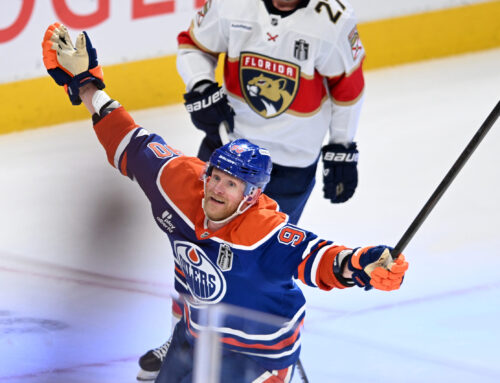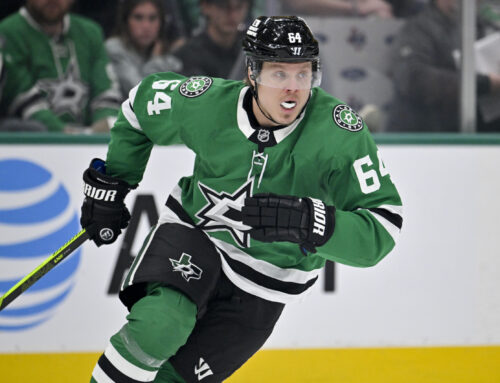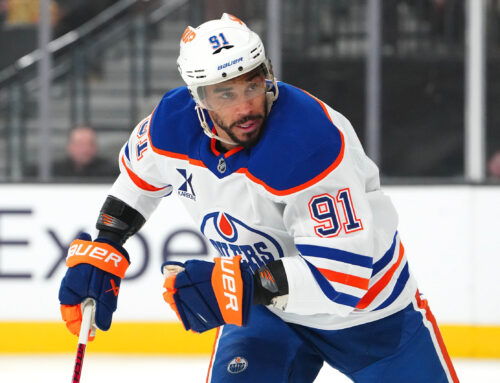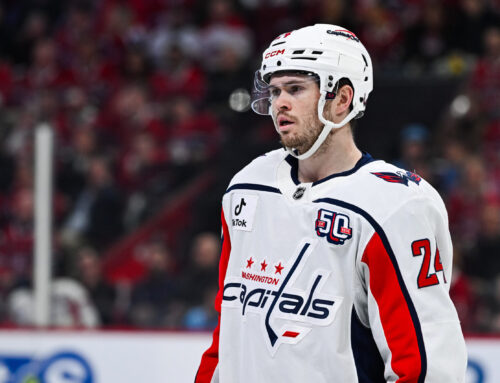You may not be able to win a fantasy hockey championship in November, but you can lay the groundwork for March and April by snagging players now that help you then.
Ever seen a trade announcement where you can’t believe the return and thought you could have beaten that offer? Smart general managers are already sniffing around impatient general managers of struggling teams, trying to get a bead on which buy-low players are available. If you can afford to roster a player until they regress to normal, these are the moves you need to be considering.
One of the keys to buying low is timing. Kyle Connor is a great recent example. Through his first nine games, he had one goal and three points. A perfect buy-low opportunity. If chose to wait to make an offer, the opportunity may have passed as he had a goal and six points in his three games heading into Sunday night's action.
Below are 10 players who are great buy-low opportunities. Keep in mind that not every GM will panic over their struggling player. Depending on your league and how smart the GMs are, you may not be able to get these players for as low as you might have hoped.
10. Michael Bunting
A year ago, Bunting was nominated for the Calder trophy, buoyed by the fact he spent much of his five-on-five time in a top-six role in Toronto. This year, he’s still in that top-six role, but the production hasn’t been there as he has six points in 14 games and only one point in his last 10 contests. Going into Sunday evening’s games, the Leafs were bottom 10 in even-strength goals, but still a top team on the power play. As Bunting doesn’t play on the top power-play unit, he hasn’t been getting the points. If you expect Auston Matthews and Mitchell Marner to rally to last year’s production levels, then Bunting will pick up points just from those rebounds.
Last Thursday, Buchnevich picked up two points, his first points in six games. Since Buchnevich missed three games with a lower-body injury, and the Blues have played the fewest number of games, it feels as if Buchnevich is producing worse than he is. On the season, he has four points in eight games. This isn’t new territory for Buchnevich. Last year, he had two points in his first two games before missing a couple of games. He then had one point in six games before dominating the rest of the year. He’s playing about 19 minutes a night and is on the top power-play unit while averaging two shots per game, so a rebound could be coming any day.
Like Connor, your opportunity to buy low on Lindholm may have passed. A year ago, Lindholm finished with 82 points in 82 contests. This year he has 10 points in 14 games, a 59-point pace. He also has only five goals, which puts him on pace for 29 goals this campaign. That’s a far cry from the 42 he put up a year ago. Maybe he’s missed Matthew Tkachuk and Johnny Gaudreau more than we realized. While his shots are down this year, Lindholm is averaging 19:39 a night. However, he now has eight points in his last eight games, so the buy-low window is almost closed. A smart GM will be aware that Lindholm is already bouncing back, but there’s still a chance the other GM will look at the overall stats and still be frustrated.
You hear it about goalies all the time. They are inconsistent. They’re voodoo. You never know from one season to the next who will struggle and who will be great. But even some of those who struggle will usually bounce back in some way. Demko is 1-8-2 with a 4.02 GAA and a .874 SV% and has given up at least three goals in every game. If you don’t believe he can bounce back, just think back to a year ago, when he was 6-10-1 in his first 17 games with a 3.07 GAA and a .904 SV%. For the rest of the season, he went 27-13-6 with a 2.60 GAA and a .919 SV%. Yes, it took the coach being fired to help with that comeback, but we have seen a rebound from Demko before. In 2020-21, he was 4-9-1 in his first 14 games. He seems to be a notoriously slow starter.
6. Sam Reinhart
Going into last season, I had given up on the idea that Reinhart could hit the 70-point plateau. After all, since he couldn’t do with tons of ice time, top power-play time and alongside Jack Eichel in Buffalo, how much more of an opportunity could he get? Then he went to Florida, playing mostly on the third line at even strength (Mason Marchment, Anton Lundell, Carter Verhaeghe and Sam Bennett were the only linemates he played at least 200 even-strength minutes with). He somehow put up 82 points in that situation. This year, he’s been promoted to the top line alongside Aleksander Barkov, and his production drops to five points in 15 games, a 27-point pace. That is tremendously awful. While a drop in power-play production (from 31 power-play points a year ago to only three so far this year) plays a substantial part, it’s not enough to account for such an overall drop. Reinhart is playing more than 20 minutes per night, is still on the top power-play unit and is averaging 3.2 shots per game (easily a career high). His shooting percentage is 4.2 per cent, whereas he averaged 17.4 per cent in the three years preceding this one.
5. Juuse Saros
It has not been an easy start to the season for Saros owners. Saros is 4-6-1 so far this year and has given up at least three goals in seven of his 11 games. He’s also never had a week with more than one win, frustrating anyone that has him in weekly head-to-head leagues. The four goals on six shots in a game last week against Seattle were especially brutal. However, remember there’s no danger of backup Kevin Lankinen stealing starts, so Saros will continue getting all the opportunities going forward. There’s also a chance the Preds’ schedule to start the season is playing a role. They played their first two games of the season in Europe and they just wrapped up a five-game west coast road trip. In four games on the road, Saros is 1-3 with a .843 SV% and a 5.17 GAA. At home, he is 3-3-1 with a .929 SV% and a 2.30 GAA.
4. Jordan Kyrou
To be honest, there are plenty of Blues that could have made this list. Besides the previously named Buchnevich, there’s also Ryan O’Reilly, Torey Krug, Ivan Barbashev, Jordan Binnington, and maybe to a lesser extent, Robert Thomas (who has five points in his last 10 games). The Blues’ power play isn’t as effective as a season ago, which could partially explain the production dropoff of so many players (it’s down seven percentage points from a year ago). Overall, the Blues are the lowest-scoring team in the league, at 2.38 goals per game. As the Blues start clicking again, so will Kyrou. His ice time is up almost two minutes per night from his breakout season a year ago, and he’s on the ice for a higher percentage of the team’s power-play minutes as well. His 3.2 shots per game are also a career high.
3. Bryan Rust
In the last three seasons, Rust has produced an 82-game pace of 83, 62 and 79 points. With eight points in 15 games, he’s on pace for 44 points and has just one point in his last seven contests. He’s also not producing with the man advantage, with three power-play points so far (last year, he had 21 power-play points in 60 games). However, there’s still a lot to like here. Rust is still in a top-six role, mostly alongside Sidney Crosby and Jake Guentzel. Rust is still on the top power-play unit and is still averaging about three shots per game. His individual points percentage (the percentage of goals scored while he is on the ice where he picks up a goal or an assist) is 47.1 per cent. For comparison, last year his IPP was 63.7 per cent. His opportunity is still there, and it’s just a matter of time before he smashes out of his slump.
The Red Wings defenseman is having one heck of a sophomore slump. A year ago, he had 50 points in 82 games. This year, he has five points in 15 games and is pointless in his last three. He lost his spot on the top power-play unit for a few games but has since reclaimed it (although on Saturday night, he lost it again). On the bright side, he’s averaging more than two hits and two blocked shots per game, but his shots per game have dropped to 1.8. He’s too good and getting too many opportunities to stay this quiet for long. This may also be the lowest you’ll ever get him in keeper leagues.
Yes, I’m recommending an injured player as a buy-low opportunity. Huberdeau has missed the last three contests, but that is probably adding to the frustration levels of many fantasy hockey general managers who drafted him in the first round. Even before the injury, Huberdeau was struggling, with six points in 11 games, including only one point in his last five matches before the injury. His 0.55 points per game is at least half of what many expected from him this year. So why buy low? Huberdeau is elite and elite players will sometimes struggle and frustrate us. Whenever you want to acquire an elite player, you want to do so when he’s struggling, not when he’s putting up 115 points. Think of what it would have cost you to acquire Huberdeau in a trade last season, and what it might require now, and you’ll see why he’s an easy choice for the top buy-low candidate.





 FLA
FLA EDM
EDM NYR
NYR MIN
MIN CGY
CGY S.J
S.J ANA
ANA SEA
SEA
